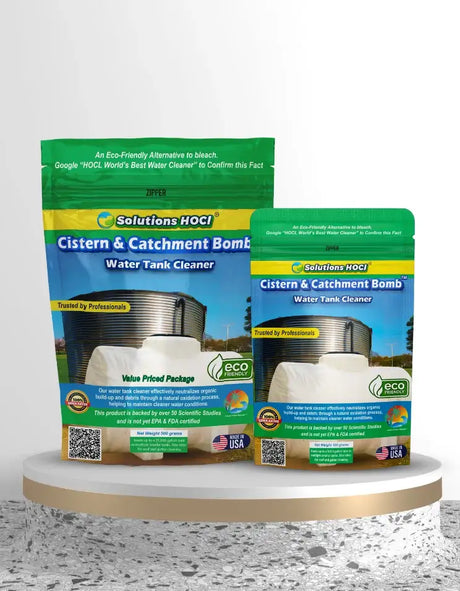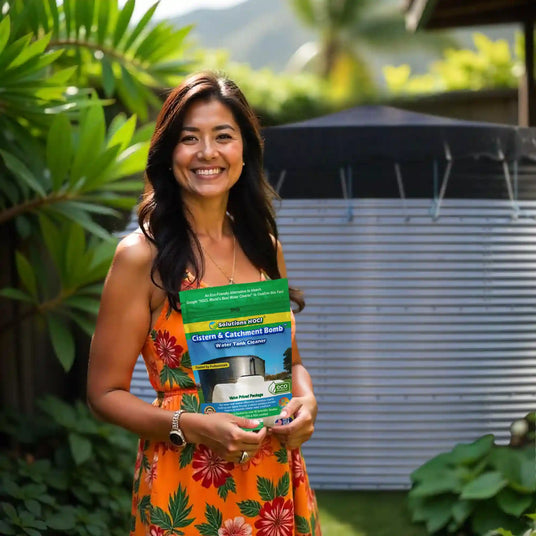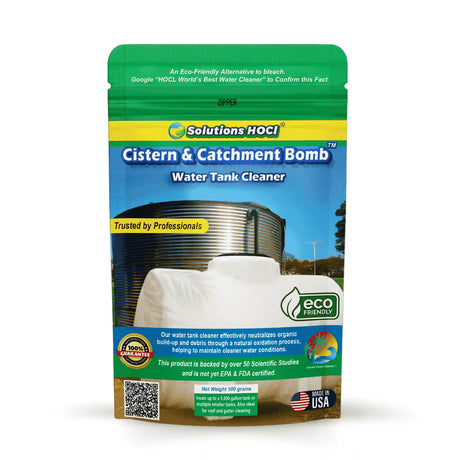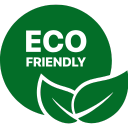

Refresh Your Tank – Naturally Clean, Effortlessly Easy
Get cleaner, odor-free water storage with our eco-friendly tank cleaner. Safe, simple, and powerful—shop now and experience the difference!
Fresh, Clean Water Tanks Start Here — Naturally Without Bleach!
Whether you’re doing a deep clean or just keeping up with routine maintenance, the Cistern & Catchment Bomb™ uses the power of Natural Oxidation to give you fresh, clean, and odor-free water—with no bleach, no harsh chemicals, and no strong smells.

Keep Your Water Tanks Fresher – The Natural Way
Managing your rainwater or cistern system doesn’t have to mean using harsh chemicals or complicated treatments. With our Cistern & Catchment Bomb Cleaner, you get a naturally effective, eco-safe solution designed to help reduce odor, slime, and buildup in your water storage systems.
Whether you’re living off-grid, relying on rainwater harvesting, or just keeping your home system clean—this easy-to-use cleaner drops directly into your tank and goes to work using the power of hypochlorous acid (HOCl), a naturally occurring compound that breaks down into simple salt and water.
No scrubbing. No bleach. Just smarter, safer tank maintenance.
What’s Inside the Bomb? Pure, Simple & Safe Ingredients
Revitalize Your Tank with Effortless Cleanliness!

The Role of Routine Tank Maintenance
Water tanks are essential for households, farms, and off-grid systems—but they’re not maintenance-free. Without regular care, tanks can accumulate organic matter, biofilm, and sediment that affect water clarity, smell, and quality. Our Cistern & Catchment Bomb Cleaner is designed to support your tank's natural balance by helping reduce that buildup through gentle, non-corrosive action. Used routinely, it helps your system stay cleaner, longer—without the use of harsh chemicals or bleaches.
Backed by Independent Research
Want to see the science? Our active ingredients are supported by extensive third-party studies and documentation. Visit our
👉 Scientific Studies page for peer-reviewed research from organizations like WHO, NIH, and others.
Why Peoploe Choose Cistern & Catchment Bomb for Tank Cleaning
Keep Your Water Fresh and Clean with Ease
What is HOCL and How Does It Function as a Water Tank Cleaner?
What is HOCL and How Does It Function as a Water Tank Cleaner?
HOCL stands for hypochlorous acid. It is an effective and powerful cleaner used to maintain water tanks and reduce harmful germs. HOCL is made naturally by the human body that may help reduce bacteria and viruses in water systems.
How HOCL Cleans Water Tanks
- Effective Disinfection: HOCL may help may help reduce bacteria and viruses in water systems.
- Gentle and Residue-Free: Unlike bleach, HOCl doesn’t leave harsh chemicals behind, ensuring the tank is suitable for use again.
- No Strong Odors: HOCL doesn’t produce strong smells or harmful fumes, making it better for people and the environment.
- Easy Application: HOCL is easy to put on, then wipe off into the tank, reaching all areas, including hard-to-reach spots where dirt and germs hide.
- Quick Action: It starts working right away, sanitizing the tank quickly and efficiently.
- No Rinsing Needed: After cleaning, there is usually no need to rinse the tank, as HOCL breaks down into harmless substances.
Benefits of HOCL Over Bleach
- Better for Humans and the Environment: HOCL is Superior to bleach and doesn’t produce toxic fumes.
- Protects Tank Materials: It doesn’t cause damage or corrosion to the tank like bleach can.
- Prevents Algae and Biofilms: HOCL helps stop the growth of algae and biofilms, keeping the tank clean longer.
- Cost-Effective: Over time, using HOCL can be more economical than bleach.
- Better Water Quality: Ensures that the water remains clean and free from chemical residues.
Using HOCL as a water tank cleaner is a great choice. It cleans effectively while being eco-friendly and easy to use, making it Superior than traditional bleach cleaners.
Are the ingredients in Cistern & Catchment Tank Bomb - Water Tank Cleaner Biodegradable and Eco-Friendly?
Are the ingredients in Cistern & Catchment Tank Bomb - Water Tank Cleaner Biodegradable and Eco-Friendly?
The Cistern & Catchment Bomb Cleaner from SolutionsHOCL® contains the following primary ingredients:
- Sodium-based NaDCC
- Sodium Sulfate
- Sodium Bicarbonate
According to the product description, these components are described as eco-friendly
In general, Sodium bicarbonate are known to be biodegradable and environmentally benign. Sodium sulfate is an inorganic salt that is highly soluble in water and is not considered harmful to the environment in typical concentrations. Sodium dichloroisocyanurate (NaDCC) releases hypochlorous acid (HOCl) upon dissolution, which is a biodegradable compound.
Therefore, the ingredients in the Cistern & Catchment Bomb Cleaner are considered biodegradable and environmentally friendly.
How Can We Safely Clean EPDM Liners Without Causing Damage?
How Can We Safely Clean EPDM Liners Without Causing Damage?
EPDM (Ethylene Propylene Diene Monomer) Liners
- Why Avoid Bleach? Bleach can oxidize and degrade EPDM rubber, leading to brittleness and leaks.
- Recommended Cleaning Method:
- Product: Use SolutionsHOCL® Cistern & Catchment Bomb.
- Application: Dilute the product as per instructions and apply it to the interior surfaces of the tank. Allow it to sit for the recommended time to effectively neutralize contaminants.
- Rinse: Thoroughly rinse with clean water to remove any residual cleaner.
What Is the Best Way to Clean PVC Liners Without Causing Cracks or Damage?
What Is the Best Way to Clean PVC Liners Without Causing Cracks or Damage?
PVC (Polyvinyl Chloride) Liners
- Why Avoid Bleach? Bleach can cause hardening and cracking of PVC over time.
- Recommended Cleaning Method:
- Product: Utilize SolutionsHOCL® Cistern & Catchment Bomb.
- Application: Prepare a diluted solution and gently scrub the liner with a soft brush or cloth to remove biofilm and deposits.
- Rinse: Ensure all cleaning residues are rinsed away with fresh water.
How Can We Effectively Clean Polyethylene Liners Without Risking Degradation?
How Can We Effectively Clean Polyethylene Liners Without Risking Degradation?
Polyethylene (LDPE & HDPE) Liners
- Why Avoid Bleach? Low-density polyethylene (LDPE) can degrade with bleach exposure, while high-density polyethylene (HDPE) may resist but is not immune to damage.
- Recommended Cleaning Method:
- Product: Opt for SolutionsHOCL® Cistern & Catchment Bomb.
- Application: Apply the diluted solution to the liner, allowing it to address organic contaminants effectively.
- Rinse: Flush the tank with clean water to remove any remaining cleaner.
How Can We Properly Clean Polypropylene Liners Without Causing Damage?
How Can We Properly Clean Polypropylene Liners Without Causing Damage?
Polypropylene (PP) Liners
- Why Avoid Bleach? Bleach can lead to discoloration and embrittlement of polypropylene.
- Recommended Cleaning Method:
- Product: Employ SolutionsHOCL® Cistern & Catchment Bomb.
- Application: Use the product as directed to clean the liner, ensuring it reaches all areas to eliminate microbial growth.
- Rinse: Rinse thoroughly with potable water to ensure no cleaner remains.
How Can We Effectively Clean Butyl Rubber Liners Without Compromising Their Flexibility and Integrity?
How Can We Effectively Clean Butyl Rubber Liners Without Compromising Their Flexibility and Integrity?
Butyl Rubber Liners
- Why Avoid Bleach? Similar to EPDM, bleach can deteriorate butyl rubber, compromising its flexibility and integrity.
- Recommended Cleaning Method:
- Product: Choose SolutionsHOCL® Cistern & Catchment Bomb.
- Application: Apply the diluted cleaner to the liner surface, allowing adequate contact time to break down contaminants.
- Rinse: Completely rinse the tank with clean water to remove any cleaner residue.
How Can We Effectively Clean Fiberglass Liners Without Damaging the Gel Coating?
How Can We Effectively Clean Fiberglass Liners Without Damaging the Gel Coating?
Fiberglass (Gel-Coated) Liners
- Why Avoid Bleach? Bleach can erode the gel coating, leading to absorption of chemicals and structural degradation.
- Recommended Cleaning Method:
- Product: Apply SolutionsHOCL® Cistern & Catchment Bomb.
- Application: Use the product to clean the liner, focusing on areas with visible staining or biofilm.
- Rinse: After cleaning, rinse the tank thoroughly to ensure all residues are removed.
Who relies on home water storage systems?
Who relies on home water storage systems?
Over 44 million Americans depend on private wells, rainwater tanks, and water storage systems for their daily water needs. These systems, when properly cleaned, provide reliable, clean water when city water isn't available.
Why is regular tank cleaning important?
Why is regular tank cleaning important?
Over time, water tanks can gather sediment, algae, and organic buildup that may affect water clarity and freshness. Regular cleaning helps maintain a cleaner tank environment and supports better overall water quality for household use.
How does SolutionsHOCL® Cistern & Catchment Bomb help?
How does SolutionsHOCL® Cistern & Catchment Bomb help?
Our eco-friendly formula makes tank cleaning easy. Using natural oxidation and eco-friendly ingredients dissolves water tank build-up, maintains a balanced pH, and keeps your water tank clean without harsh chemicals.
Is SolutionsHOCL® environmentally friendly?
Is SolutionsHOCL® environmentally friendly?
Yes! Our SolutionsHOCL Water Tank Cleaner is formulated from eco-friendly ingredients, making it extremely effective for your Family, and the environment. It supports sustainable water storage without compromising water quality.
How Does HOCL Cistern & Catchment Bomb Work?
How Does HOCL Cistern & Catchment Bomb Work?
The SolutionsHOCl® Cistern & Catchment Bomb uses Hypochlorous Acid (HOCl) technology to help maintain cleaner water storage tanks. Here's how it functions:
What It Does: Add 1 scoop of powder per 1,000 gallons into your water tank. The formula releases HOCl, a naturally-occurring oxidizing compound that your body also produces.
How It Functions: HOCl works through natural oxidation to help break down organic matter, algae, and buildup in water storage systems. This oxidation process helps reduce odors and slime that can accumulate over time.
Easy Process: After 30-40 minutes of contact time, oxidized organic matter floats to the surface where you can easily skim it off. This leaves your tank cleaner and helps reduce unpleasant smells.
Eco-Conscious Choice: The formula is made with biodegradable ingredients including sodium-based compounds, and sodium bicarbonate. After use, HOCl breaks down into simple salt and water, leaving no harsh chemical residues.
Scientific Background: HOCl has been extensively studied in peer-reviewed research (available on our Scientific Studies page). These studies examine HOCl's oxidation properties and its applications in various water maintenance contexts.
Understanding HOCl Technology
Technical Overview:
The SolutionsHOCl® Cistern & Catchment Bomb releases Hypochlorous Acid (HOCl) from a sodium-based formula (NaDCC). Here's the science:
1. Formula Activation:
- Dosage: 1 scoop per 1,000 gallons
- Upon dissolving in water, the NaDCC compound undergoes hydrolysis to release HOCl:
NaDCC + H₂O → HOCl + NaCl + Cyanuric Acid - This creates a neutral-pH solution that optimizes HOCl's oxidative properties compared to bleach (NaOCl), which becomes less effective at higher pH levels.
2. Oxidation Process:
- Natural Oxidation: HOCl functions as an oxidizing agent that helps break down organic matter in water storage systems. The compound's neutral charge allows it to interact with organic materials more effectively.
- Chemical Reaction: The oxidation process can be represented as:
HOCl + Organic Matter → Oxidized Compounds + H₂O - Odor & Algae Management: HOCl helps oxidize compounds that contribute to unpleasant odors and can help reduce algae growth through its oxidative properties.
3. Research Foundation:
Our approach is informed by peer-reviewed scientific literature available at solutionshocl.com/pages/scientific-studies:
- Gordon et al. (2015): Examines HOCl's environmental profile, noting its breakdown into salt and water with minimal environmental impact.
- Fukuzaki (2006): Details HOCl's oxidation mechanisms and interaction with organic materials.
- Barrette (2003): Studies HOCl's oxidative properties and reactivity at neutral pH.
- Albemarle Corporation (2021): Analyzes HOCl's ability to oxidize chlorophyll and organic compounds in water systems.
- McDonnell & Russell (1999): Explores HOCl's mechanism of protein oxidation in various applications.
- Wang et al. (2007): Confirms HOCl's safety profile in environmental applications.
- Rutala & Weber (2004): Examines HOCl applications in various cleaning contexts.
- Edward & Lidwell (1943): Early research on HOCl's oxidative properties.
4. Practical Application:
- After 30-40 minutes, oxidized organic materials aggregate and float to the surface
- This allows for easy manual removal by skimming
- The process helps maintain clearer, fresher-smelling water storage
- Stabilizers (sodium bicarbonate) help maintain optimal pH for HOCl stability
5. Eco-Friendly Profile:
- Post-use, HOCl naturally breaks down into chloride ions and water
- No harsh chemical residues remain in the tank
- Biodegradable formula supports sustainable water storage maintenance
- WHO recognizes HOCl as an environmentally-conscious oxidizing compound
6. Comparison to Traditional Methods:
- HOCl operates effectively at neutral pH, unlike bleach which requires alkaline conditions
- The neutral charge of HOCl allows better interaction with organic materials
- Breaks down into benign compounds (salt + water) rather than leaving chemical residues
- Gentler on tank liners and materials compared to harsh bleach solutions
What Makes This Different from Bleach?
Material Safety:
- Unlike bleach, HOCl-based formulas are designed to be gentler on common tank liner materials including EPDM, PVC, polyethylene, polypropylene, butyl rubber, and fiberglass
- Bleach can cause degradation, brittleness, and discoloration of these materials over time
- Our formula helps protect your investment in your water storage system
User Experience:
- No harsh chemical odors or fumes during application
- No need for protective equipment like gloves or respirators
- Easier to work with for routine maintenance tasks
- Formula is designed for convenient home use
Environmental Considerations:
- Biodegradable ingredients that break down naturally
- No toxic byproducts or persistent chemical residues
- More sustainable approach to water tank maintenance
- Supports eco-conscious water management practices








































